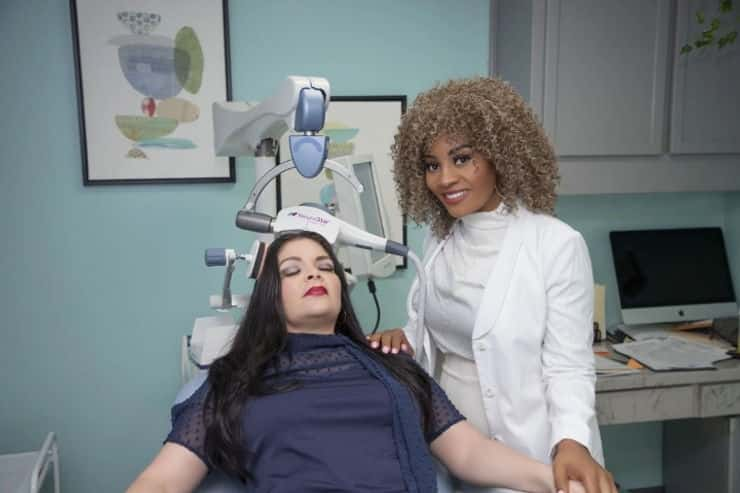
Have you ever felt like you’re at your wit’s end with depression treatments? Pills, therapy sessions, and everything under the sun, yet nothing seems to click? Well, there’s this thing called Transcranial Magnetic Stimulation (TMS) that’s been making waves, and it’s not as sci-fi as it sounds. Let’s break it down together.
On this Blog :
What is TMS?
Imagine a friend tapping you on the shoulder to get your attention, except this friend is a bit more sophisticated and speaks directly to your brain. That’s the essence of Transcranial Magnetic Stimulation, or TMS for short. It’s a non-invasive way to tell your brain, “Hey, let’s try to cheer up a bit, shall we?
Now, if you’re picturing something out of a Frankenstein movie with bolts of electricity, let’s clear that up right now. TMS is far from that. It’s a modern, refined procedure that’s more about finesse than brute force.
- Magnetic Fields: The tool used in TMS is a coil that generates magnetic pulses. These aren’t just any pulses; they’re carefully calibrated to target specific areas of the brain known to play a big role in mood regulation.
- Brain Stimulation: When the coil is activated, it creates an electromagnetic field that can pass through the skull (without any discomfort, mind you) and stimulate the brain cells underneath. It’s like waking them up from a deep slumber.
- A Gentle Approach: One of the beauties of TMS is its non-invasiveness. There are no surgeries, no anesthesia, and no need for a hospital stay. You sit comfortably, the coil is placed near your head, and the technician starts the session. You might feel a light tapping sensation, but that’s about it.
The science behind TMS is fascinating. It taps into the brain’s natural ability to form new connections and pathways, a process known as neuroplasticity. By stimulating these specific areas of the brain, TMS encourages the brain to “rewire” itself in a way that can alleviate symptoms of depression.
It’s a testament to how far we’ve come in understanding the brain and how to gently coax it into a healthier state. TMS isn’t just a treatment: it’s a beacon of hope for those who have felt stuck in the shadows of depression, offering a path towards the light.
How Does TMS Work?
- It’s All About the Magnets: A special coil is placed near your head, and it generates brief magnetic pulses.
- Brain Nudge: These pulses pass through your skull (nope, it doesn’t hurt) and stimulate the brain cells responsible for your mood.
- Consistency is Key: Sessions usually last around 30 to 60 minutes and are done 5 days a week for 4 to 6 weeks.
Who Can Try TMS?
TMS isn’t for everyone, and it’s not the first line of attack against depression. It’s typically considered when:
- The merry-go-round of medications isn’t cutting it.
- Side effects from antidepressants are just too much.
- You’re looking for a non-medication based treatment.

The Real Deal: Does TMS Work?
You’re probably wondering, “All this sounds great, but does TMS really do the trick?” It’s the million-dollar question, isn’t it? Let’s sift through the hopeful buzz and get down to what matters: real results.
First off, it’s essential to understand that TMS isn’t a one-size-fits-all solution. Just like each of us has our unique quirks and charms, our brains respond to treatments in their own unique ways. However, the stories of transformation can be nothing short of miraculous.
- Science Speaks Volumes: Clinical studies and real-life experiences have shown that TMS can significantly reduce symptoms of depression, particularly in individuals who haven’t found relief through traditional methods. We’re talking about rigorous research here, not just hearsay.
- Beyond the Numbers: But let’s put the science aside for a moment. Imagine feeling like you’re stuck under a heavy, gray cloud day in and day out. Then, gradually, thanks to TMS, you start noticing moments when the sun seems to peek through. These moments become more frequent and longer-lasting. That’s the kind of change many people have reported – a gradual but noticeable return of joy, energy, and hope.
- A Ripple Effect: The benefits of TMS often extend beyond just alleviating depressive symptoms. People talk about improved sleep, better focus, and a renewed interest in hobbies and social activities. It’s like getting reintroduced to the joys of life that seemed lost.
- Hearing It from the Source: Personal testimonials carry a weight of their own. There are countless stories of individuals who felt they were out of options, only to find a new lease on life with TMS. These stories are powerful, not just for their outcomes but for the shared journey of struggle, resilience, and eventual breakthrough.
But, and there’s always a but, it’s crucial to remember that TMS isn’t a magic bullet. Some folks may see dramatic improvements, while others might experience more subtle shifts. And, as with any treatment, there are those for whom TMS might not be the right fit.
The takeaway here? TMS offers a promising avenue for those battling with depression, especially for whom other treatments haven’t been effective. It’s a testament to the advances in mental health treatment and a reminder that hope is always on the horizon. If you’re considering TMS, it’s worth having a heart-to-heart with your healthcare provider to see if it could be your pathway to brighter days.
What to Expect from a TMS Session
Let’s take a peek into what a typical TMS session feels like:
- Before You Start: You’ll chat with a doctor to make sure TMS is a good fit for you.
- During the Session: You sit in a comfy chair, the coil is placed on your head, and the machine does its thing. You’ll hear a clicking sound and feel a tapping sensation on your scalp.
- After the Session: You can just bounce back to your day. No downtime needed.
Wrapping It Up
TMS might sound like it’s straight out of a sci-fi novel, but it’s a real-deal option for those battling with depression. It’s all about giving your brain a little nudge to help it find its way back to the sunshine. If you’ve been on a long journey with depression and haven’t found your path yet, TMS could be worth a chat with your doctor.
Remember, everyone’s journey with mental health is unique, and what works for one person might not work for another. The most important thing is to keep exploring your options, asking questions, and holding onto hope. Because your mental health journey? It’s worth every step, every try, every day.


